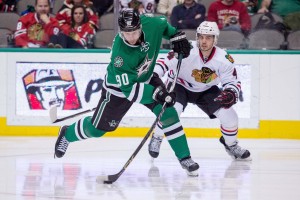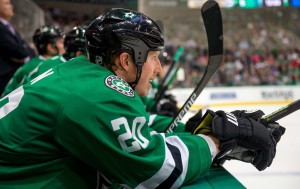When a team is eight games above .500 and has three times as many wins as it does losses, it’s often easy for even the most cynical of fans to ignore chinks in their beloved club’s armor. The Dallas Stars are no exception; they got off to a record start, they’ve held late leads and gotten above-average goaltending, and they find themselves at the top of the Central Division in overall points.
However, there are certainly some weaknesses in Dallas’ game that could end up bringing the Stars back to Earth as they move deeper into the season. Let’s take a look at five things the Stars need to do better in order to continuing riding their unprecedented hot streak.
Faceoffs
Of the players who are consistently asked to take draws for the Stars, Jason Spezza is leading the way with a faceoff winning percentage of 54.2 percent. Tyler Seguin falls in just behind Spezza with an even 54 percent, and Vernon Fiddler barely cracks the halfway mark with 50.8 percent. Among the Stars’ centers, those three are the only players above that 50 percent plateau; Radek Faksa has won 48 percent of his draws, Cody Eakin has won 42.7 percent and Mattias Janmark, who has also been asked to play quite a bit wing for Dallas, has been victorious just 36.1 percent of the time.

Seguin has admittedly gotten better on the dot since his arrival in Dallas, but his nearly team-leading 54 percent still leaves a lot to be desired. A quick scan of NHL.c0m’s stats reveals two centermen with winning percentages of greater than 60 percent and at least 15 games played (Jonathan Toews, Tomas Hertl) and four over 59 percent.
Ideally, the Stars need to get either Seguin or Spezza operating on this elite level; if they can’t, they need each of their centers to at least approach 50 percent on a consistent basis. Dallas has the ability to feed off of great puck-posession numbers, but they need to earn the puck of the draw more often in order to click on all cylinders.
We are going to want to win the occasional faceoff at some point.
— Bob Sturm (@SportsSturm) November 4, 2015
Playing Stronger Games Against Weaker Teams
The Stars’ four losses have come against Colorado, Florida, and Toronto. Combined, those teams have a record of 14-23-8. While it isn’t realistic for any team to have stellar performances every night and begin a season 16-0, if the average Stars fan would have been asked to predict which four of the first 16 games the Stars would lose, it’s hard to imagine that any would have picked the four that actually tripped the club up.
While these losses are bad enough in themselves, the manner in which the Stars have lost these games has been worse. Two of the defeats have come on the heels of impressive road trips as Dallas has fallen victim to the dreaded first game back. In addition, the Stars blew their first third-period lead of the season Tuesday against Toronto, which is a demon all too familiar to the Stars from the 2014-15 campaign.
While “trap games” and the laying of eggs are a part of any team’s season year in and year out, Dallas needs to start taking care of the games that it is expected to win; in a division as hellish as the Central, those points could prove to be incredibly valuable.
Tonight was the first time this season that the Stars surrendered a third-period lead.
— Josh Bogorad (@JoshBogorad) November 11, 2015
Depth Scoring
The Stars’ offense is lighting the lamp at a blistering pace, ranking second in goals for per game. However, outside of the club’s top scoring threats (which are admittedly many), some of Dallas’ role players aren’t matching the rate of production they’ve shown themselves capable of. Mattias Janmark has cooled off dramatically as far as getting on the scoresheet, Val Nichushkin has just three points despite playing some of his best hockey in Dallas in the last several games and Cody Eakin has just six points in 16 contests after racking up 40 points in 78 games last season.

Before you cry foul, let’s be clear about one thing; the Stars offense is not in trouble by any stretch of the imagination to this point in the season. Everyone who watches this team for any amount of time knows they will put pucks in the net at an absurd pace, and they have the personnel to do it up and down the lineup. However, the superstar tandem of Jamie Benn and Seguin are the unquestioned load-carriers through 16 games, collecting 21 and 23 points, respectively. What if the duo (or the NHL’s top-scoring defenseman John Klingberg) cools off? While it can seem like they never will when things are going right, slumps happen; just ask the Patrick Sharp of a few weeks ago.
While depth offense may be the least threatening of the items on this list, there is definitely room for growth among the Stars’ bottom-tier forwards. The Dallas attack is already arguably the most formidable in the league; if the bottom-six can begin to chip in at even a slightly higher rate, the sky might truly be the limit.
Penalty Killing
While the Stars’ power play is playing off the charts through the beginning of the season, their penalty kill has been borderline awful. They’re killing just 76.6 percent of their infractions, good for 24th in the league. Winning the special teams battle often leads to winning hockey games, and right now Dallas is doing it through the brute force of their deadly power play; if it can find a way to bring that penalty kill number up to a more respectable level, the club’s special teams advantage would skyrocket.
In Need of Another Response
None of this is to say that the Stars and their 12-4 record are flukes or that Dallas’ excellent play is unsustainable. This team is much improved from 2014-15; head coach Lindy Ruff is getting big saves and consistent netminding, a commitment to team defense, a high-powered offensive attack and a duo of elite scorers playing out of their minds. With that being said, the Stars will need to do what they’ve managed to through this point of the season and respond to a poor loss with a win on Thursday.
The road doesn’t get any easier, but if the Stars can continue to play a strong two-way game within Ruff’s system and shore up some of the less-refined portions of their game, the optimism and excitement coursing through Dallas should continue to be rewarded with victories from the men in “Victory Green.”